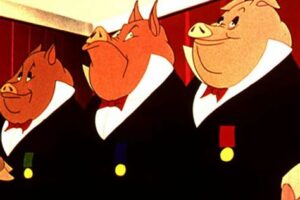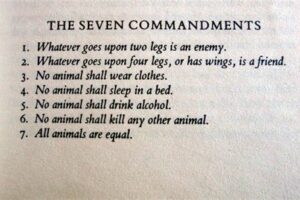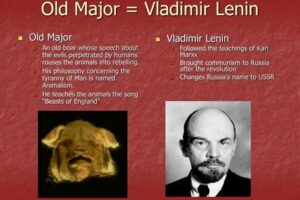Table of Contents
Discover the symbolic representation of Animal Farm characters in the Russian Revolution. Explore how Orwell’s animals reflect key historical figures.
The characters in Animal Farm represent various figures and groups involved in the Russian Revolution. From the conniving pigs to the passive horses, each character embodies a specific trait or ideology that played a role in the historical events leading up to the establishment of Soviet Russia. Through their actions and interactions, George Orwell paints a vivid picture of the complex social and political landscape of that time. As we delve deeper into the story, we discover how the characters’ personalities and motivations mirror those of the real-life individuals they represent. With its compelling narrative and thought-provoking themes, Animal Farm offers a unique perspective on one of the most significant events in modern history.
The Russian Revolution of 1917 was a monumental event that changed the course of history. It was marked by fierce political struggles, social upheavals, and the overthrow of the Tsarist regime. George Orwell’s Animal Farm, published in 1945, is a satirical novel that allegorizes the Russian Revolution and the rise of Stalinism. In this article, we will explore the key characters in Animal Farm and their real-life counterparts during the Russian Revolution.
Old Major
Old Major is the wise old boar who inspires the animals to rebel against their human oppressors. He represents the role of Karl Marx and Vladimir Lenin, who were the intellectual leaders of the Bolshevik Revolution. Old Major’s teachings on animal rights and equality reflect Marx’s philosophy of communism, which aimed to create a classless society based on the principles of cooperation and collective ownership.
Napoleon
Napoleon is a power-hungry pig who gradually becomes a dictator and rules the farm with an iron fist. He represents Joseph Stalin, who rose to power after Lenin’s death and established a totalitarian regime in the Soviet Union. Napoleon’s manipulation of language, propaganda, and violence reflect Stalin’s tactics of purges, show trials, and censorship.
Snowball
Snowball is a charismatic pig who is initially a rival to Napoleon for leadership of the animals. He represents Leon Trotsky, who was a Marxist revolutionary and a key figure in the early Soviet government. Snowball’s vision of animal utopia, his plans for windmills and education, and his defense against human attacks reflect Trotsky’s ideals of permanent revolution, internationalism, and military strategy.
Squealer
Squealer is a small, fat pig who is Napoleon’s chief propagandist and spokesperson. He represents the Soviet media, which was controlled by the Communist Party and used to glorify Stalin and demonize his enemies. Squealer’s ability to twist the truth, justify the regime’s actions, and manipulate public opinion reflects the role of propaganda in totalitarian regimes.
Boxer
Boxer is a strong, loyal horse who works hard for the cause of animal liberation. He represents the working class and peasant farmers, who were the backbone of the Bolshevik Revolution and the Soviet economy. Boxer’s devotion to the party, his simple-mindedness, and his tragic fate reflect the exploitation and manipulation of the proletariat by the ruling elite.
Benjamin
Benjamin is a cynical donkey who is skeptical of the revolution and its leaders. He represents the intellectuals and dissidents who criticized the Soviet regime and faced repression and persecution. Benjamin’s refusal to take sides, his pessimism, and his enigmatic presence reflect the complexity and ambiguity of political dissent in totalitarian societies.
Mollie
Mollie is a vain, materialistic mare who cares more about her appearance and comfort than the revolution. She represents the bourgeoisie and aristocracy, who enjoyed privileges and luxuries under the Tsarist system and opposed the Bolsheviks. Mollie’s defection to the humans, her rejection of the animal values, and her hedonistic lifestyle reflect the class conflict and social inequality that persisted in the Soviet Union.
Mr. Jones
Mr. Jones is the drunken, incompetent farmer who mistreats his animals and triggers the rebellion. He represents the Tsar Nicholas II, who was a weak and unpopular ruler and failed to address the social and economic problems of his country. Mr. Jones’s neglect of his duties, his cruelty to his animals, and his eventual expulsion from the farm reflect the downfall of the Romanov dynasty and the end of the old order.
The Sheep
The sheep are a flock of docile, obedient animals who follow the party line without question. They represent the masses and the general public, who were indoctrinated and manipulated by propaganda and ideology. The sheep’s mindless chanting of slogans, their lack of critical thinking, and their blind loyalty to the leaders reflect the dangers of mass conformity and the erosion of individual freedom in totalitarian societies.
The Dogs
The dogs are a pack of ferocious, loyal animals who serve as Napoleon’s enforcers and secret police. They represent the security forces and paramilitary groups that were used to suppress dissent and maintain order in the Soviet Union. The dogs’ violence, aggression, and blind obedience to their master reflect the brutal tactics and repression that characterized totalitarian regimes.
Conclusion
In conclusion, the characters in Animal Farm represent the different actors and forces that shaped the Russian Revolution and its aftermath. Through their actions and interactions, Orwell satirizes the failures and contradictions of the communist ideology, the corruption and cruelty of the Stalinist regime, and the human cost of the political struggle for power. By using animals as his protagonists, Orwell highlights the universal themes of oppression, resistance, and freedom that transcend the boundaries of time and place.
In George Orwell’s Animal Farm, the characters are allegorical representations of the key players in the Russian Revolution. The cunning and manipulative Napoleon represents Joseph Stalin, who rose to power after the death of Vladimir Lenin. Boxer, the horse, represents the working class proletariat of Russia, who were often exploited and mistreated by those in power. Snowball, the pig, represents Leon Trotsky, the intellectual and passionate counterpart to Napoleon. Squealer, the pig, represents the propaganda machine of the Soviet Union, which was used to manipulate and control the masses. Old Major, the pig who inspires the rebellion, represents Karl Marx, the intellectual and philosophical creator of communism. Benjamin, the donkey, represents the pessimistic and skeptical intellectuals of the Russian Revolution, who were critical of the new regime and its leaders. Moses, the raven, represents the Russian Orthodox Church, which was often used as a tool of the government to control the population. Mollie, the horse, represents the bourgeoisie, the wealthy and privileged members of society who were resistant to change and often aligned themselves with the old regime. Mr. Jones, the farmer who is overthrown, represents Tsar Nicholas II, the leader who was overthrown in the revolution. The animal rebellion itself represents the October Revolution, the violent overthrow of the old regime. The animals overthrow Mr. Jones and take control of the farm, but they soon find themselves under the control of Napoleon and his inner circle. This mirrors the way that Stalin rose to power after Lenin’s death and used propaganda and violence to maintain his grip on the country. Through the use of these allegorical characters, Orwell is able to provide a powerful commentary on the Russian Revolution and the dangers of totalitarianism. He shows how even a revolution that starts with good intentions can be corrupted and co-opted by those in power. The characters in Animal Farm serve as a warning to future generations about the dangers of giving too much power to a select few and the importance of remaining vigilant against those who seek to manipulate and control others.
Once upon a time, on a farm in Russia, animals decided to overthrow their human owner. This rebellion was a reflection of the Russian Revolution that took place in 1917. George Orwell’s Animal Farm is a political allegory that depicts the events of the Russian Revolution and uses animals to represent historical figures. Let’s explore the characters and their significance.
The Animals
- Old Major (pig): represents Karl Marx and Vladimir Lenin, who were the leaders of the Communist Party. He inspired the animals to rebel against Mr. Jones, just like Marx and Lenin inspired the working-class people to revolt against the bourgeoisie.
- Napoleon (pig): represents Joseph Stalin, who became the leader of the Soviet Union after Lenin’s death. Like Napoleon, Stalin was a ruthless dictator who eliminated his opponents and built a cult of personality.
- Snowball (pig): represents Leon Trotsky, who was one of the leaders of the Bolshevik Party but was eventually exiled by Stalin. Similarly, Snowball was chased away from the farm by Napoleon’s dogs.
- Squealer (pig): represents propaganda and manipulation. He uses language to justify Napoleon’s actions and convince the other animals that everything he does is for their own good.
- Boxer (horse): represents the working-class people who were loyal to the Communist Party but were exploited and betrayed. Boxer works hard for the revolution but is eventually sent to the knacker’s yard when he is no longer useful.
- Mollie (horse): represents the bourgeoisie and aristocracy who were resistant to change and preferred to maintain their privileges. She is not interested in the revolution and eventually leaves the farm to live a comfortable life.
- Benjamin (donkey): represents the intellectuals and skeptics who were critical of the Communist Party but did not actively oppose it. He is cynical and pessimistic about the revolution and does not believe that anything will change.
The story of Animal Farm is a cautionary tale about the dangers of totalitarianism and the importance of individual freedom. By using animals as symbols, Orwell was able to create a powerful satire that exposed the flaws of the Russian Revolution and the Soviet Union. The characters in Animal Farm represent historical figures, but they also embody universal themes and ideas that are relevant today.
Dear fellow readers,As we conclude this article about the representation of Animal Farm characters in the Russian Revolution, it is important to reflect on the significance of the novel and its relevance to our world today.Firstly, we can see the parallels between the characters in Animal Farm and the key figures of the Russian Revolution. For instance, Napoleon, the power-hungry pig, mirrors Joseph Stalin, the dictator of the Soviet Union. Both characters use propaganda and fear tactics to maintain their hold on power, and both prioritize their own interests above those of their people.Similarly, Snowball, the idealistic pig who is eventually exiled from the farm, represents Leon Trotsky, the revolutionary who was ousted by Stalin. Both Snowball and Trotsky had grand visions for a better society, but were ultimately betrayed by their comrades and forced into exile.Furthermore, the themes explored in Animal Farm are still relevant today. The dangers of authoritarianism, the importance of free speech and the struggle for equality are all issues that continue to shape our world. The novel serves as a cautionary tale about the dangers of unchecked power, and the need for vigilance in the face of oppression.In conclusion, Animal Farm remains a powerful commentary on the Russian Revolution and the dangers of totalitarianism. Its characters serve as reminders of the key players in the revolution, and the themes explored are still relevant to our world today. Let us take heed of Orwell’s warning and remain vigilant in the face of tyranny.Thank you for taking the time to read this article, and may it inspire you to reflect on the lessons of history and their significance for our present and future.Sincerely,[Your Name].
People also ask about what Animal Farm characters represent in the Russian Revolution:
-
What does Old Major represent?
Old Major represents Karl Marx, the founder of communism. He is the one who inspires the animals to rebel against their human oppressors.
-
Who does Napoleon represent?
Napoleon represents Joseph Stalin, the dictator who rose to power in the Soviet Union after the death of Vladimir Lenin. Like Napoleon, Stalin was ruthless and authoritarian, using violence and propaganda to maintain his grip on power.
-
What does Snowball represent?
Snowball represents Leon Trotsky, a revolutionary who was a key figure in the early days of the Soviet Union. Like Snowball, Trotsky was eventually exiled and later assassinated by Stalin.
-
What do the other animals represent?
The other animals represent different groups within society. For example, Boxer the horse represents the working class, while Mollie the horse represents the bourgeoisie. The sheep represent the masses who are easily swayed by propaganda.
-
What does the farm itself represent?
The farm represents the Soviet Union under Stalin’s rule. The animals’ rebellion against their human oppressors represents the Bolshevik Revolution, while the subsequent corruption of the revolution by the pigs represents Stalin’s betrayal of the ideals of communism.
In conclusion, George Orwell’s Animal Farm is a powerful allegory that uses animal characters to represent real-life figures and events from the Russian Revolution. By doing so, Orwell exposes the dangers of totalitarianism and warns against the abuse of power.






